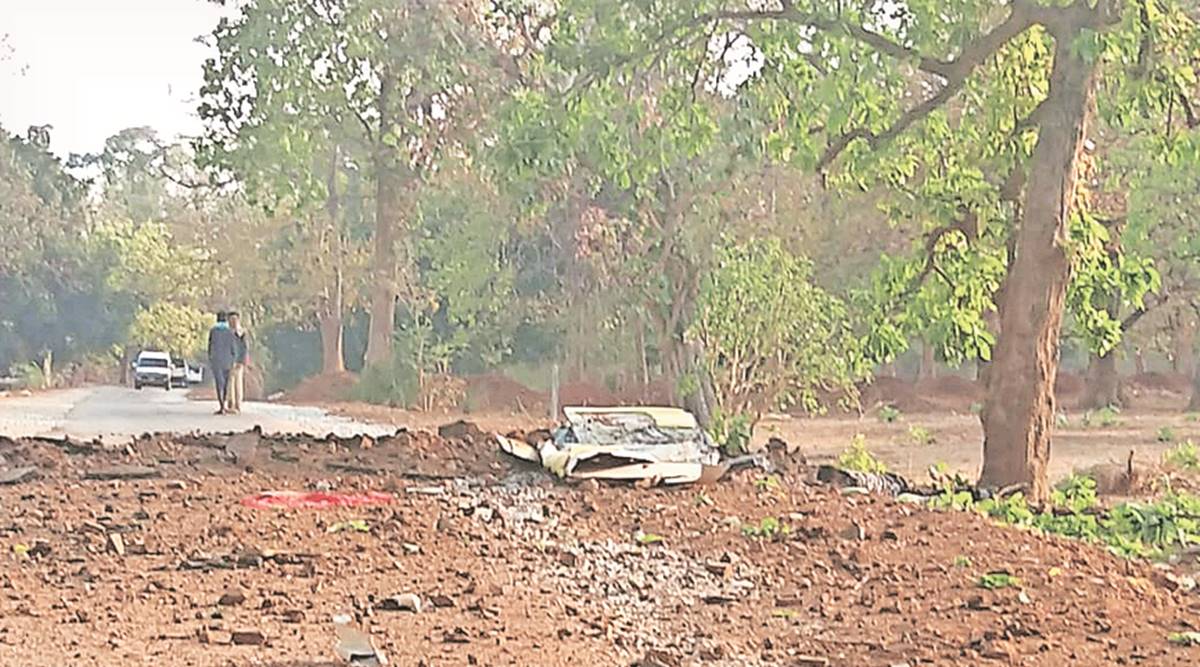 The site of a Naxal attack in Dantewada in 2019. (File)
The site of a Naxal attack in Dantewada in 2019. (File) Police in Dantewada have begun a periodic survey to ascertain the nature and level of the Maoist presence in villages of the district.
The first ‘Panchayatwar Naxal Samvedanshilta ka Survey’ (Panchayat-wise Naxal Sensitivity Survey) was carried out in January this year, and again in July. Dantewada Police plan to get all 149 gram panchayats in the district to fill out the survey twice every year.
Some of the questions in the survey are: “Do armed Naxals hold meetings in your village? Do armed Naxals stay in the village? Does the village have basic facilities of electricity, water, road, or school?”
There are also questions on whether a Naxal incident had been recorded in the area during the past year, and whether the village panchayat representatives lived in the village.
The survey is the brainchild of Dantewada Superintendent of Police Abhishek Pallava, and is intended to collect data on the basis of which gram panchayats can be classified into green, yellow, and red zones — green denoting a Naxal-free area, yellow being a Naxal-sensitive area, and red being a Naxal hyper-sensitive area.
“We make claims of Naxal dominance decreasing in the villages, but there is no data to back it. We are trying to get this survey done every six months, to ensure that we have an understanding of the area,” Pallava said.
Respondents — the sarpanch, teacher, anganwadi worker, or other government functionaries apart from villagers — are expected to answer the questions in “Yes” or “No”.
If all the questions related to Maoists are answered with a “No”, the village is declared a ‘green’ village. If even one of the questions is answered with a “Yes”, the village becomes a ‘yellow’ village. For a village to be marked ‘red’, villagers and government functionaries must respond to Questions 1, 4, and 5 in the survey — which ask whether a Naxal incident had been recorded in the village over the past year, and whether armed Naxals visited and/or stayed in the village — with a “Yes”.
“In green areas, we get around 15-20 people to fill in the survey. Villages where fewer people are willing to be surveyed, which we already know are in areas with Maoist presence, automatically become a ‘red’ village,” Pallava said.
According to Dantewada Police, the situation has improved since the baseline survey was conducted in January. Police had then recorded 33 red villages, 42 yellow villages, and 74 green villages. By July, these numbers had changed to 26, 34, and 89 for red, yellow, and green villages respectively.
Among the 15 new green villages are Gamawada and eight other villages in Dantewada block, two villages in Geedam block, and one in Kuakonda block of the district.
“This mapping is helping us find out which area is the most sensitive, and which area needs greater intervention from the administration. With our questionnaire, we are also trying to find out how many villages have members of [Naxal] front organizations active in them. This would reduce antipathy towards police as well, as villagers want their regions to be declared green,” Pallava said.
He added that a more comprehensive 100-question survey is being developed to fine-tune details from the villages that are turning green, in order to collect additional feedback on the findings of the police.
Bastar Inspector General of Police Sundarraj Pattilingam said analysis of the Maoist presence in a district wasn’t new, though the nomenclature of the zones might differ.
“It helps us figure out if our policing is working, and also helps us to identify where the DRG (the anti-Naxal District Reserve Guard) needs to be mobilised, and where police stations can manage their areas. This is a process carried out at all levels — nationally, within the state, and in individual districts,” the IGP said.
Deepak Baij, the Congress Lok Sabha MP from Bastar, said he was not aware of the findings of the police survey. “I have come to know about the survey through the media. I will be able to comment once the survey is completed,” Baij said.
Congress leader Chavindra Karma, son of the late Mahendra Karma who was killed in the 2013 Naxal attack in Darbha, said the police were overreaching. “How are the police, who are claiming that Maoism has reduced, carrying out such a survey? Why isn’t the revenue department or another department looking into gathering this information?” he asked.
Chavindra’s sister Tulika Karma, also a Congress leader, said: “It is very important to find out who is conducting the survey and how much knowledge of the area they have. It is good to know where the Maoist presence is less, but a competent authority which is independent, needs to carry out the survey.”
- The Indian Express website has been rated GREEN for its credibility and trustworthiness by Newsguard, a global service that rates news sources for their journalistic standards.

